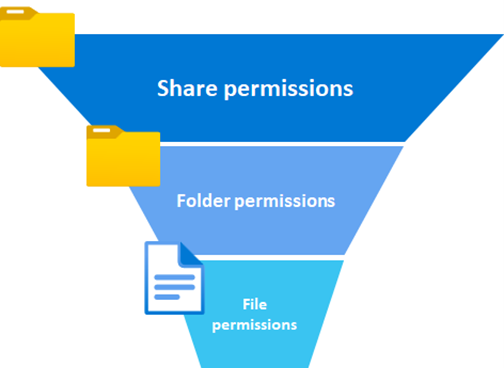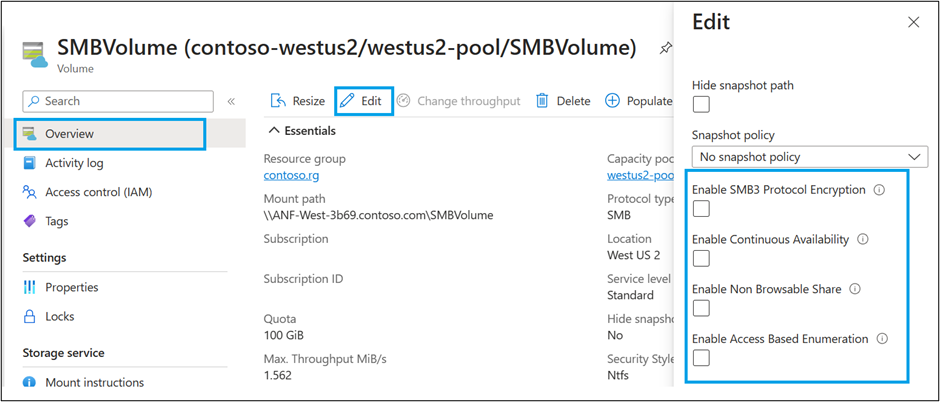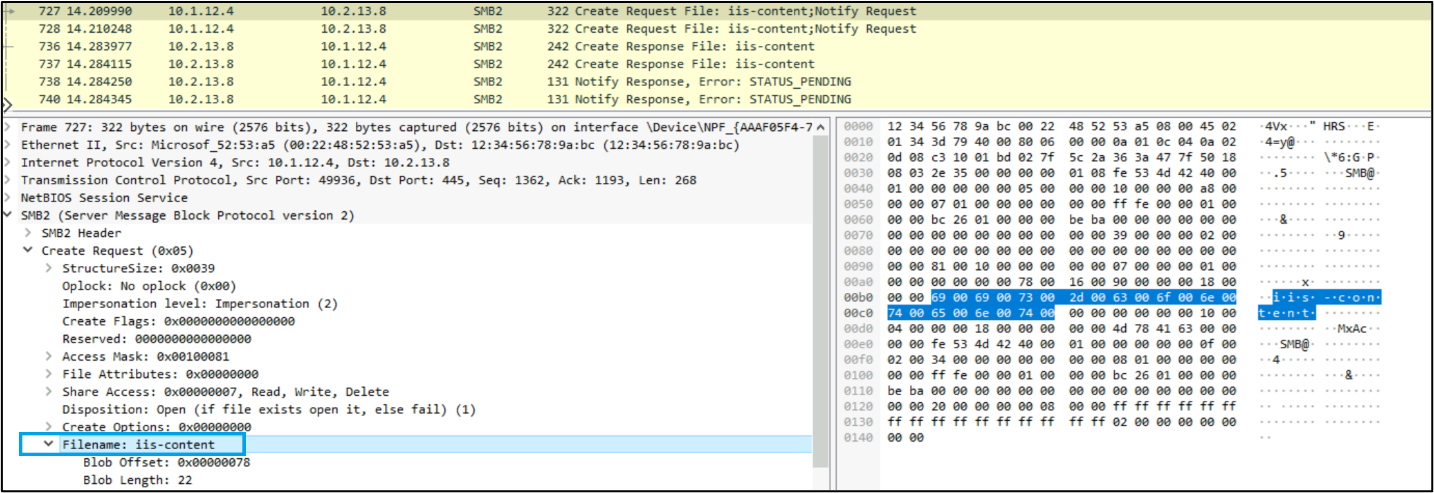Note
Access to this page requires authorization. You can try signing in or changing directories.
Access to this page requires authorization. You can try changing directories.
Azure NetApp Files provides several ways to secure your network attached storage (NAS) data. One aspect of that security is permissions. In NAS, permissions can be broken down into two categories:
- Share access permissions limit who can mount a NAS volume. NFS controls share access permissions via IP address or hostname. SMB controls this via user and group access control lists (ACLs).
- File access permissions limit what users and groups can do once a NAS volume is mounted. File access permissions are applied to individual files and folders.
Azure NetApp Files permissions rely on NAS standards, simplifying the process of security NAS volumes for administrators and end users with familiar methods.
Note
If conflicting permissions are listed on share and files, the most restrictive permission is applied. For instance, if a user has read only access at the share level and full control at the file level, the user receives read access at all levels.
Share access permissions
The initial entry point to be secured in a NAS environment is access to the share itself. In most cases, access should be restricted to only the users and groups that need access to the share. With share access permissions, you can lock down who can even mount the share in the first place.
Since the most restrictive permissions override other permissions, and a share is the main entry point to the volume (with the fewest access controls), share permissions should abide by a funnel logic, where the share allows more access than the underlying files and folders. The funnel logic enacts more granular, restrictive controls.
NFS export policies
Volumes in Azure NetApp Files are shared out to NFS clients by exporting a path that is accessible to a client or set of clients. Both NFSv3 and NFSv4.x use the same method to limit access to an NFS share in Azure NetApp Files: export policies.
An export policy is a container for a set of access rules that are listed in order of desired access. These rules control access to NFS shares by using client IP addresses or subnets. If a client isn't listed in an export policy rule—either allowing or explicitly denying access—then that client is unable to mount the NFS export. Since the rules are read in sequential order, if a more restrictive policy rule is applied to a client (for example, by way of a subnet), then it's read and applied first. Subsequent policy rules that allow more access are ignored. This diagram shows a client that has an IP of 10.10.10.10 getting read-only access to a volume because the subnet 0.0.0.0/0 (every client in every subnet) is set to read-only and is listed first in the policy.
Export policy rule options available in Azure NetApp Files
When creating an Azure NetApp Files volume, there are several options configurable for control of access to NFS volumes.
- Index: specifies the order in which an export policy rule is evaluated. If a client falls under multiple rules in the policy, then the first applicable rule applies to the client and subsequent rules are ignored.
- Allowed clients: specifies which clients a rule applies to. This value can be a client IP address, a comma-separated list of IP addresses, or a subnet including multiple clients. The hostname and netgroup values aren't supported in Azure NetApp Files.
- Access: specifies the level of access allowed to non-root users. For NFS volumes without Kerberos enabled, the options are: Read only, Read & write, or No access. For volumes with Kerberos enabled, the options are: Kerberos 5, Kerberos 5i, or Kerberos 5p.
- Root access: specifies how the root user is treated in NFS exports for a given client. If set to "On," the root is root. If set to "Off," the root is squashed to the anonymous user ID 65534.
- chown mode: controls what users can run change ownership commands on the export (chown). If set to "Restricted," only the root user can run chown. If set to "Unrestricted," any user with the proper file/folder permissions can run chown commands.
Default policy rule in Azure NetApp Files
When creating a new volume, a default policy rule is created. The default policy prevents a scenario where a volume is created without policy rules, which would restrict access for any client attempting access to the export. Without rules, there's no access to the volume.
The default rule has the following values:
- Index = 1
- Allowed clients = 0.0.0.0/0 (all clients allowed access)
- Access = Read & write
- Root access = On
- Chown mode = Restricted
These values can be changed at volume creation or after the volume has been created.
Export policy rules with NFS Kerberos enabled in Azure NetApp Files
NFS Kerberos can be enabled only on volumes using NFSv4.1 in Azure NetApp Files. Kerberos provides added security by offering different modes of encryption for NFS mounts, depending on the Kerberos type in use.
When Kerberos is enabled, the values for the export policy rules change to allow specification of which Kerberos mode should be allowed. Multiple Kerberos security modes can be enabled in the same rule if you need access to more than one.
Those security modes include:
- Kerberos 5: Only initial authentication is encrypted.
- Kerberos 5i: User authentication plus integrity checking.
- Kerberos 5p: User authentication, integrity checking and privacy. All packets are encrypted.
Only Kerberos-enabled clients are able to access volumes with export rules specifying Kerberos; no AUTH_SYS access is allowed when Kerberos is enabled.
Root squashing
There are some scenarios where you want to restrict root access to an Azure NetApp Files volume. Since root has unfettered access to anything in an NFS volume – even when explicitly denying access to root using mode bits or ACLs—the only way to limit root access is to tell the NFS server that root from a specific client is no longer root.
In export policy rules, select "Root access: off" to squash root to a non-root, anonymous user ID of 65534. This means that the root on the specified clients is now user ID 65534 (typically nfsnobody on NFS clients) and has access to files and folders based on the ACLs/mode bits specified for that user. For mode bits, the access permissions generally fall under the “Everyone” access rights. Additionally, files written as “root” from clients impacted by root squash rules create files and folders as the nfsnobody:65534 user. If you require root to be root, set "Root access" to "On."
To learn more about managing export policies, see Configure export policies for NFS or dual-protocol volumes.
Export policy rule ordering
The order of export policy rules determines how they're applied. The first rule in the list that applies to an NFS client is the rule used for that client. When using CIDR ranges/subnets for export policy rules, an NFS client in that range might receive unwanted access due to the range in which it's included.
Consider the following example:
- The first rule in the index includes all clients in all subnets by way of the default policy rule using 0.0.0.0/0 as the Allowed clients entry. That rule allows “Read & Write” access to all clients for that Azure NetApp Files NFSv3 volume.
- The second rule in the index explicitly lists NFS client 10.10.10.10 and is configured to limit access to “Read only,” with no root access (root is squashed).
As it stands, the client 10.10.10.10 receives access due to the first rule in the list. The next rule is never be evaluated for access restrictions, thus 10.10.10.10 get Read & Write access even though “Read only” is desired. Root is also root, rather than being squashed.
To fix this and set access to the desired level, the rules can be re-ordered to place the desired client access rule above any subnet/CIDR rules. You can reorder export policy rules in the Azure portal by dragging the rules or using the Move commands in the ... menu in the row for each export policy rule.
Note
You can use the Azure NetApp Files CLI or REST API only to add or remove export policy rules.
SMB shares
SMB shares enable end users can access SMB or dual-protocol volumes in Azure NetApp Files. Access controls for SMB shares are limited in the Azure NetApp Files control plane to only SMB security options such as access-based enumeration and nonbrowsable share functionality. These security options are configured during volume creation with the Edit volume functionality.
Share-level permission ACLs are managed through a Windows MMC console rather than through Azure NetApp Files.
Security-related share properties
Azure NetApp Files offers multiple share properties to enhance security for administrators.
Access-based enumeration
Access-based enumeration is an Azure NetApp Files SMB volume feature that limits enumeration of files and folders (that is, listing the contents) in SMB only to users with allowed access on the share. For instance, if a user doesn't have access to read a file or folder in a share with access-based enumeration enabled, then the file or folder doesn't show up in directory listings. In the following example, a user (smbuser) doesn't have access to read a folder named “ABE” in an Azure NetApp Files SMB volume. Only contosoadmin has access.
In the below example, access-based enumeration is disabled, so the user has access to the ABE directory of SMBVolume.
In the next example, access-based enumeration is enabled, so the ABE directory of SMBVolume doesn't display for the user.
The permissions also extend to individual files. In the below example, access-based enumeration is disabled and ABE-file displays to the user.
With access-based enumeration enabled, ABE-file doesn't display to the user.
Non-browsable shares
The nonbrowsable shares feature in Azure NetApp Files limits clients from browsing for an SMB share by hiding the share from view in Windows Explorer or when listing shares in "net view." Only end users that know the absolute paths to the share are able to find the share.
In the following image, the nonbrowsable share property isn't enabled for SMBVolume, so the volume displays in the listing of the file server (using \\servername).
With nonbrowsable shares enabled on SMBVolume in Azure NetApp Files, the same view of the file server excludes SMBVolume.
In the next image, the share SMBVolume has nonbrowsable shares enabled in Azure NetApp Files. When that is enabled, this is the view of the top level of the file server.
Even though the volume in the listing can't be seen, it remains accessible if the user knows the file path.
SMB3 encryption
SMB3 encryption is an Azure NetApp Files SMB volume feature that enforces encryption over the wire for SMB clients for greater security in NAS environments. The following image shows a screen capture of network traffic when SMB encryption is disabled. Sensitive information—such as file names and file handles—is visible.
When SMB Encryption is enabled, the packets are marked as encrypted, and no sensitive information can be seen. Instead, it’s shown as "Encrypted SMB3 data."
SMB share ACLs
SMB shares can control access to who can mount and access a share, as well as control access levels to users and groups in an Active Directory domain. The first level of permissions that get evaluated are share access control lists (ACLs).
SMB share permissions are more basic than file permissions: they only apply read, change or full control. Share permissions can be overridden by file permissions and file permissions can be overridden by share permissions; the most restrictive permission is the one abided by. For instance, if the group “Everyone” is given full control on the share (the default behavior), and specific users have read-only access to a folder via a file-level ACL, then read access is applied to those users. Any other users not listed explicitly in the ACL have full control
Conversely, if the share permission is set to “Read” for a specific user, but the file-level permission is set to full control for that user, “Read” access is enforced.
In dual-protocol NAS environments, SMB share ACLs only apply to SMB users. NFS clients leverage export policies and rules for share access rules. As such, controlling permissions at the file and folder level is preferred over share-level ACLs, especially for dual=protocol NAS volumes.
To learn how to configure ACLs, see Manage SMB share ACLs in Azure NetApp Files.













